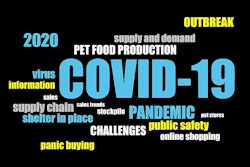
Sponsored content by Emmert
Over the years, the pet food industry has seen a growing demand from consumers for sustainability. That should be great news—sustainability is inherent to the way the pet food industry operates. We work hand-in-hand with the human food industry, preserving the energy that goes into crops and livestock by converting every healthful part into fuel for people and their pets. We consider the impact of manufacturing, looking for ways to save energy and resources and passing those savings on to the consumer. We respect the natural cycle by ensuring nothing goes to waste.
Unfortunately, consumers often see these strengths as weaknesses. Sensationalized stories lead pet parents to conclude that we use leftovers from the manufacturing process—ingredients that aren’t “good enough” for human consumption.
Recently I had the opportunity to visit a meat packing plant. As the workers sliced prime beef into premium steaks, they set trimmings into a large bin that was soon brimming with fresh, high-quality meat and marrow-rich bones—and it was destined for a nearby pet food facility.
I wish every pet owner could also see that source of premium, copurposed ingredients and the way the human food and petfood industries work hand in hand. Few consumers would object to their pets getting such top-notch ingredients. In fact, they are just the kind of thing a loving pet parent might sneak under the table at dinnertime.
And yet, this is not what most consumers picture when they read the word “byproduct” on a label.
Transforming the Narrative—Starting with Ourselves
How can we change these perceptions?
The first—and most difficult—step is to change our own attitude. Too often, we treat our work with the human food industry as a source of embarrassment. We know the nutritional and environmental benefits of this mutual cooperation, but we minimize it because we worry about the perception of using “leftovers.”
We need to reframe this thinking. In many food processes, roughly half of the product goes into the human food chain and half into the pet food chain. Pet food ingredients are not leftovers from these processes any more than human food ingredients are. They are coproducts—equally important components simply used in different ways.
The brewer’s yeast we use at F.L. Emmert Company is a great illustration of this. Brewer’s yeast is a nutrient-dense liquid derived from brewing beer. Consumers might think of brewer’s yeast as a coproduct but biologically speaking, it is the main product. Yeast uses the carbohydrate-rich liquid for nutrition, then excretes what it doesn’t need as alcohol and carbon dioxide.. The yeast multiplies, resulting in a food that is high in B vitamins, minerals, and protein—while also creating beer.
Although brewer’s yeast is used to some extent in human foods, most of its health benefits would go to waste if not used by the pet food and livestock industries. The same is true for the meat trimmings at that meat packing plant, and for countless other nutritious coproducts.
Telling Our Sustainability Stories
As an industry, we have always had an attitude of resourcefulness, looking at what’s available and making the most of it to benefit everybody. When we use coproducts to maximize animal health, we demonstrate stewardship over available resources. This should be a source of pride. By communicating this truth to consumers, we can overcome the stigma associated with coproducts. We can flip public perceptions around.
One way to do this could be through marketing campaigns that highlight the harmonious relationship between pet food and human food companies. Ads could introduce consumers to our partners that farm and process food. The ads would explain the crucial role of pet food in supporting our agricultural economy—to the tune of $6.9 billion a year in the United States alone, according to the Institute of Feed Education and Research. Beyond advertising, our labels could put greater emphasis on the nutritional and ecological benefits of coproducts, pointing out how they add nutritional value.
While coproducts should be a key part of any sustainability message, they do not need to be the sole focus. We can continue in this spirit of ingenuity by keeping an eye on our supply chain and products for stewardship opportunities. This might mean emphasizing the recyclable and reusable nature of our product packaging, or redesigning it where appropriate to enhance our sustainability story. In product development, it might mean taking cues from the human food market to create more efficient, innovative ways of delivering maximum nutrition to pets.
I have no doubt our industry is full of creative, resourceful individuals who are up to this sustainability challenge.
Let’s create a future in which consumers see coproducts of the human food industry as a selling point for pet food—both because of their nutritional value and their smaller environmental footprint. Just like us, consumers want a more sustainable world for themselves and their pets. By sharing our own sustainability stories, we can lead the way.
Elizabeth Barber is Executive Vice President at the F.L. Emmert Company.















